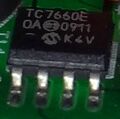Difference between revisions of "Victor 70C"
Jump to navigation
Jump to search
Uwe Hermann (talk | contribs) m |
|||
| Line 4: | Line 4: | ||
See [[Victor 70C/Info]] for more details (such as '''lsusb -vvv''' output) about the device. | See [[Victor 70C/Info]] for more details (such as '''lsusb -vvv''' output) about the device. | ||
The USB protocol this device uses to communicate with the PC is documented on the [[Victor protocol]] page. | |||
== Hardware == | == Hardware == | ||
| Line 12: | Line 14: | ||
* [http://datasheet.octopart.com/TLC27L2CP-Texas-Instruments-datasheet-151061.pdf Texas Instruments 27L2C] precision dual op-amp | * [http://datasheet.octopart.com/TLC27L2CP-Texas-Instruments-datasheet-151061.pdf Texas Instruments 27L2C] precision dual op-amp | ||
* Unknown USB interface chip (HID) | * Unknown USB interface chip (HID) | ||
Note: the USB/HID chip is ''in the multimeter'' (not in the USB cable/connector) for this device. The device is connected to the PC using a standard USB cable (without any internal logic/chip). | |||
== Photos == | == Photos == | ||
| Line 26: | Line 30: | ||
</gallery> | </gallery> | ||
== Resources == | == Resources == | ||
Revision as of 23:49, 28 September 2012
The Victor 70C is a 4000 counts, CAT II handheld digital multimeter with USB connectivity. It is also sold as the EZA EZ-735.
See Victor 70C/Info for more details (such as lsusb -vvv output) about the device.
The USB protocol this device uses to communicate with the PC is documented on the Victor protocol page.
Hardware
- Fortune Semiconductor FS9922-DMM4 multimeter chip
- NXP HEF4066BT quadruple bilateral switches
- Microchip TC7660E charge pump DC-to-DC voltage converter
- Texas Instruments 27L2C precision dual op-amp
- Unknown USB interface chip (HID)
Note: the USB/HID chip is in the multimeter (not in the USB cable/connector) for this device. The device is connected to the PC using a standard USB cable (without any internal logic/chip).
Photos
Resources
- RoastLogger: Input Devices (Victor Victor 86B/86C support)
- Dave Ansell Science Communication: Victor 86C multimeter USB encoding for linux (PHP)
- victor86b-usb-interface: USB interface for Victor 86B Digital Multimeter using HIDAPI (see also here)
- Sparkfun: Victor 70C (manual, software)
- Github: victor70c (HIDAPI)
- Random review / photos








